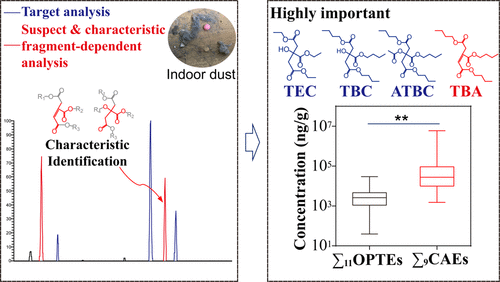当前位置:
X-MOL 学术
›
Environ. Sci. Technol.
›
论文详情
Our official English website, www.x-mol.net, welcomes your feedback! (Note: you will need to create a separate account there.)
Identifying Citric Acid Esters, a Class of Phthalate Substitute Plasticizers, in Indoor Dust via an Integrated Target, Suspect, and Characteristic Fragment-Dependent Screening Strategy
Environmental Science & Technology ( IF 11.4 ) Pub Date : 2021-10-01 , DOI: 10.1021/acs.est.1c04402 Yayun Zhang 1 , Jianhua Li 1 , Guanyong Su 1
Environmental Science & Technology ( IF 11.4 ) Pub Date : 2021-10-01 , DOI: 10.1021/acs.est.1c04402 Yayun Zhang 1 , Jianhua Li 1 , Guanyong Su 1
Affiliation

|
Citrate acid esters (CAEs) have been proposed as a class of phthalate substitute plasticizers; however, information on their occurrence in indoor environments is rare. By using liquid chromatography coupled with a quadrupole-Orbitrap mass spectrometer, we developed an integrated strategy that can be applied for target, suspect, and characteristic fragment-dependent screening of CAEs. In n = 50 indoor dust samples collected from Nanjing City (China), three CAEs, namely, acetyl tributyl citrate (ATBC; mean: 412,000 ng/g), tributyl citrate (TBC, 11,600 ng/g), and triethyl citrate (TEC, 10,900 ng/g), exhibited the greatest contamination levels. Total concentrations of CAEs (∑8CAEs) were statistically significantly (p < 0.01) greater than those of common organophosphate triesters (OPTEs), a class of ubiquitous contaminants in dust. Suspect and characteristic fragment-dependent screening (m/z 111.0078 ([C5H3O3]+) and m/z 129.0181 ([C5H5O4]+)) of CAEs were further conducted for the same batch of samples. We tentatively identified six novel CAEs, and the most frequent and abundant CAE was fully identified as tributyl aconitate (TBA). Statistically significant correlation relationships were observed on dust levels between TBA vs ATBC (r = 0.650; p < 0.01) and TBA vs TBC (r = 0.384; p < 0.01), suggesting their similar sources in dust samples.
更新日期:2021-10-19


























 京公网安备 11010802027423号
京公网安备 11010802027423号